To present my final images, I put them in a virtual 3D exhibition on ArtSteps. You can view it here.



I think that my final outcome (photobook) was successful. There is a strong and clear message that travels through the book, and I think the images, layout, text complement each other well. I think there are areas where I could have improved however. This would include the use of a slightly larger range of subject matter within my images, as well as perhaps a more conscientious use of typefaces. I chose the font because I felt it was simple and clear, but there were probably more fonts that could have been more effective. I feel that my double-page spreads are the strongest parts of the book, but I also feel that my choice to include a continuous interview throughout was very effective. It makes the subject more human and it creates a more direct experience for the viewer to make it feel as if they are speaking to him personally.
I believe I did realise my intentions with this book. I have created a series of images linked by one clear thread. The brief of nostalgia is clearly met through the use of referential archive images, and I think the mirroring between new and old imagery is important to the narrative. I also managed to convey clearly the fact that surfing is essentially my dad’s whole life and something that he is constantly chasing.
I think that I have effectively made reference to my chosen artists, but not all of them. A lot of my images could be compared to those of Arnold Newman. Note the image found on the inside cover.


Also, I was able to replicate some of Roni Horn’s style in the final outcome. Her abstract use of water texture can be seen in some of my images.

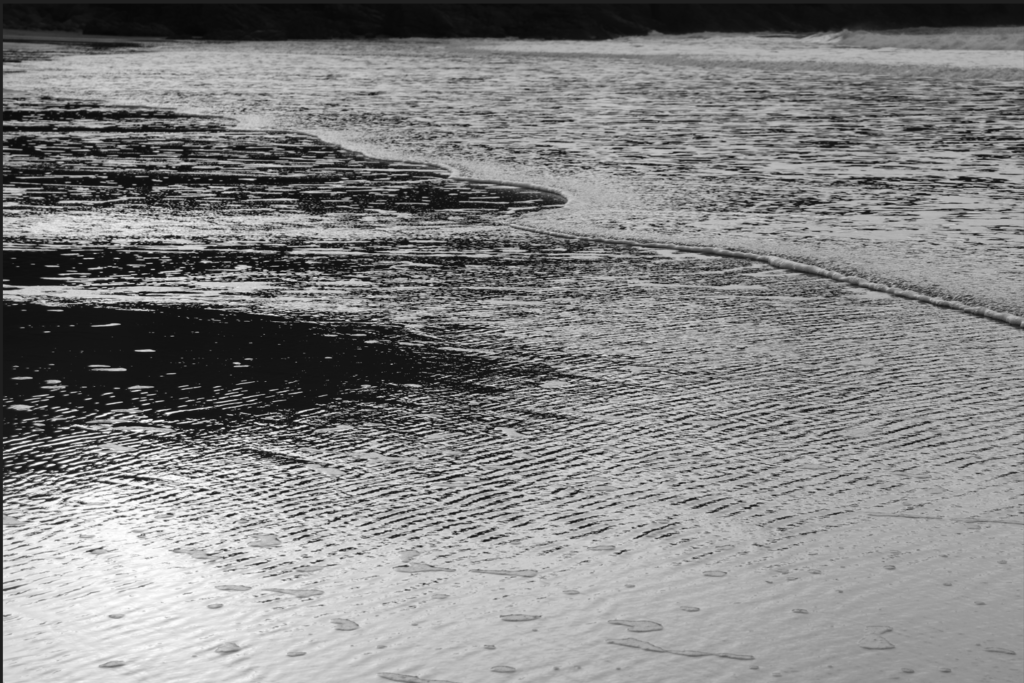
Furthermore, I think it is fairly clear that W. Eugene Smith’s work has influenced my final outcome. This is because of the use of close up and establishing shots, as well as more formal portraits. Additionally, the use of an interview is reminiscent of his essay techniques.


My conceptual approach links to Smith because I went in with the intentions of creating a study of my dad and his lifestyle, although perhaps I did not manage to produce enough images from other areas of his life, which creates a slight lack of range and complexity.
I used a documentary style when composing my images, but I also added some more landscape and abstract based photographs to ensure it was versatile and varied. If I could do it again, to create more of a documentary approach, I would have taken more environmental portraits to frame my dad in every area of his life which would have created a more rounded and interactive character.
In editing my images, I generally used a few techniques, including Black and White, increased warmth, and decreased warmth. I did this to create a series of images that were linked by their colour schemes. The monochrome ones were dramatic and simple, and the others varied in their elements of drama and nostalgia.
Overall, this project has taught me more about expanding my methods of conveying a narrative. I have enjoyed exploring different types of shots, layouts, and typefaces and I think this has been a valuable creative experience and it will certainly influence my later work.



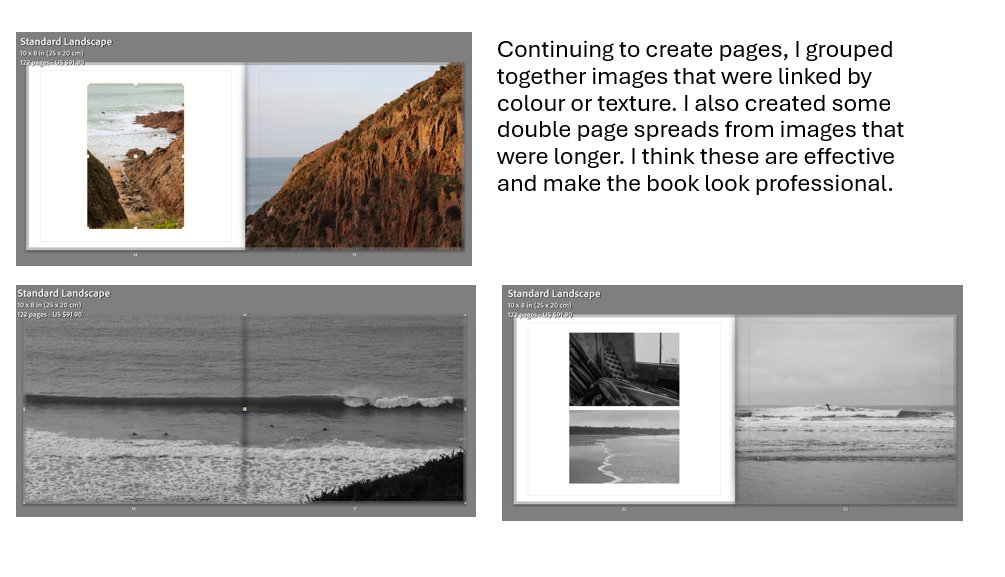

Here was my final layout:
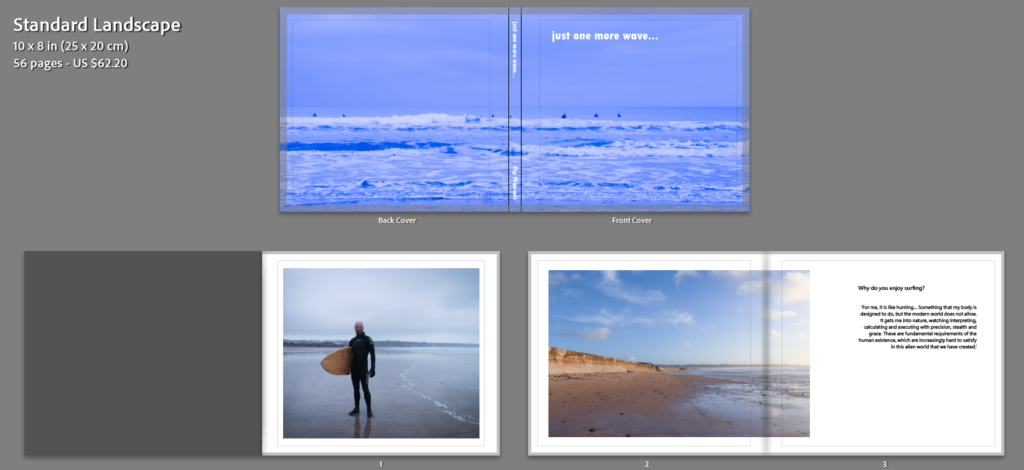







This layout includes a variation of double page spreads, full pages, and bordered images. I think this works effectively as an entire piece because it is minimal but also interesting. I chose to put the sunset and walking away image as the final spread because I think these work well as closing images for the piece. I think the use of colour and texture has been well observed and incorporated. If I could change something about this, I would possibly have tried to create a larger range of imagery, as I feel as thought sometimes it becomes a little repetitive. However, I think I have managed to balance it well.
My final title was ‘just one more wave…’ because it is exactly what my dad says if asked how much longer he will be in the water.
You can view my final book here.

I have chosen these images for my final selection to put into the photobook. I may well still remove images from this collection, but these are the ones I will go into Blurb with.
I decided to use the Lightroom brush tool to edit this image.

I liked the way the colours worked here, but I thought that it would be effective to make it look as though the rest of the image was black and white whilst having my dad and his brightly coloured clothes in colour. I think this is symbolic of the way that he always dresses colourfully and is always focused on the fun side of every situation. He always seems to be the most colourful person in the room, with the rest fading into black and white. I am happy with the outcome of this image, but I am not fully sure if I will use it in the final project.
I decided to ask my dad some questions on the role of surfing in his life because I think it will be an interesting and important addition to my final photobook. The questions and answers are as follows.
Why do you enjoy surfing?
For me, it is like hunting… Something that my body is designed to do, but the modern world does not allow. It gets me into nature, watching interpreting, calculating and executing with precision, stealth and grace. These are fundamental requirements of the human existence, which are increasingly hard to satisfy in this alien world that we have created.
When did you start/How did you start?
I started surfing around (marginally before) my 21st birthday because I moved to Cornwall from the Midlands. Surfing therefore became available to me. I honestly think that I would have always been a surfer if it had been available. I always craved, exciting, energetic, acrobatic activities. As a child, I had aspirations to be a ski jumper/cliff diver/Olympic gymnast. Like surfing, they were unrealistic dreams for somebody growing up in a Midland town, without much money. Therefore, as soon as one of these types of activities became accessible to me, I seized the opportunity with both hands, both feet, whatever I could grasp it with.
What draws you to surfing/How are you still drawn to it after so many years?
My previous answers, explain some of what draws me to surfing.
It is also a lot to do with showing off. I don’t mind admitting that I have always enjoyed the feeling of displaying my talents. This is true for any performer, it’s about feeding off the energy of the onlookers… sometimes that is envy, sometimes that is awe, most of the time it can be stated more modestly as enjoyment and appreciation. As a surfer, these good feelings come my way both in the water and out of the water, especially as I have got older… the youthful mind/body/spirit that is maintained by the activity, carries into the rest of my life, giving me a rare sense of confidence and self-worth in just about every walk of life.
What is the best thing about it?
I’m afraid I could never choose a favourite thing, I’m just not decisive enough, so I shall simply add to the positives that I’ve already described… it is a great leveller. Over the years, by chance, I have surfed with people who are extremely wealthy, world famous actors and musicians… people who, ordinarily operate in much lofty circles than me. But when we are in the water, we are all nothing but vulnerable human beings, naked in the face of nature. Whoever can tame and dance with these great forces, with the greatest prowess, becomes the star of the show for that particular moment. Kings and queens can literally become humbled and star struck by paupers and outcasts.
How has it impacted your life?
In all of the aforementioned positive ways, but also in some negative ways. It is an addictive lifestyle. Possibly one of the most healthy addictions you could have, but nonetheless the definition of an addiction is something that you continue to do and to chase, even when you know it is causing you harm.
In the grand scheme, with true objectivity and end-of-life hindsight, perhaps I wouldn’t describe it as harmful. But in the shorter term, I can honestly say that it makes relationships very difficult to maintain. The flipside of loving surfing is loathing commitment. My innate loathing of commitment is grossly incompatible with the modern cultural norm. The older I get, the more and more separate from society I feel.
Where is the best place you have ever surfed?
The ocean.
How does photography act as an important form of communication of both true and untrue subjects?
‘A photograph passes for incontrovertible proof that a given thing happened. The picture may distort; but there is always a presumption that something exists, or did exist, which is like what’s in the picture.’ (Sontag, 1977)
Ever since the dawn of photography, its usefulness, both in cultivating the mindset of the viewer toward the subject and in communicating a message visually, has been its allure. I will be analysing the work of pioneer photo essayist W. Eugene Smith, the widely commented-on war photographer Robert Capa, and important documentary photographer of the Depression era, Dorothea Lange. This is because their work all serves a function to tell a story. Whether or not it is a true story is the key to understanding the photographer’s individualism (and, arguably, integrity) as an artist.
Historically, the truthfulness of an image is always indefinite. Photography was first used by the rich to take family portraits. These were staged and composed entirely by the photographer. The subjects’ serious demeanours and plain body language is demonstrative in itself of just how far photography has evolved since those days of long exposures and big, inconvenient equipment. The equipment used to take pictures was yet another reason for the staging of photography; it was far easier to construct a composition than to allow the world to compose itself before a long exposure. As Susan Sontag states in her 1977 publication, On Photography, ‘That age when taking photographs required a cumbersome and expensive contraption—the toy of the clever, the wealthy, and the obsessed—seems remote indeed from the era of sleek pocket cameras that invite anyone to take pictures.’ (Sontag, 1977). It is clear that the progress of industrialisation has made the camera far more accessible and hence widened the art form irrefutably. Furthermore, there was an equivalent to ‘Photoshopping’ in the days before digital imagery – photographers would manipulate the darkroom development process to create images that were more appealing to their vision. Airbrushing, dodge and burn, and blurring were all tools used by the photographer to make small (and some less small) changes to their images. Therefore, the credibility of images throughout the history of photography is uncertain. Historian of Russia David King published a photobook in 1997 called The Commissar Vanishes, which discusses the erasure of enemies of the state in official photographs throughout the Stalinist era. It is described by King as ‘a terrifying – and often tragically funny – insight into one of the darkest chapters of modern history.’ (King, 1997)

It is a perfect demonstration of how the manipulation of photographs can alter how we view history and its events; and, hence, how important it is to maintain a discourse on the truthfulness of an image. The erasure of a subject means we have no way of telling exactly who was present at the time it was taken, which only contributes to the thick cloud of uncertainty around what exactly occurred during the terror era. Furthermore, a lack of transparency on what is staged and what is candid can also cause issues in determining history’s true events. The example I will discuss in this essay is Robert Capa’s Death of a Loyalist Soldier (1936), which is one of the most famously debated images of all time. In the case of more honest photographs – such as those taken in situ – they make accessible what is inaccessible; they allow those who, in a bygone age where travel is expensive and infrequent, cannot witness alternative lifestyles and cultures to their own to access this in a new medium. This is why the work of W. Eugene Smith was so important at the time; it was both educational and exciting for those who were unable to see it for themselves. Therefore, the importance of photography in relaying the events of history should not be understated – it is imperative that we as artists continue to use the medium to its advantages; to both document and inform.
The photo essays created by W. Eugene Smith between 1945 and his death in 1978 explore a variety of subjects, ranging from Minamata (1974), which explored the horrors of the mercury poisoning disaster in Minamata, Japan, to Nurse Midwife (1951), which told the story of an African American South Carolina nurse and midwife named Maude Callen.

Smith’s work is constantly empathetic and he always worked tirelessly in his pursuit of the story – when photographing the invasion of Okinawa in 1945, he was critically wounded, and when he was photographing for his final essay in Japan, he was violently beaten by workers at the chemical factory who didn’t want his photographs to expose the suffering of the poison victims. This is illustrative of Smith’s devotion to his craft. This insatiable need to capture is a trait seen in many photographers, and it truly characterises his work. The structure of his photo essays has been replicated many times since they were published, by other artists who saw how successful the structure was in relaying the tale that Smith wanted to tell. This is perhaps why he has repeatedly been described as ‘perhaps one of the greatest photojournalists America has ever produced.’ (McGuire, 1999), and it is said that ‘the combination of innovation, integrity, and technical mastery in his photography made his work the standard by which photojournalism was measured for many years.’ (The International Center of Photography (ICP), n.d.) However, because of his insatiable and unending desire to photograph, there was an enduring issue with copyright across Smith’s work, namely his essay from Minamata, Japan. The photograph titled Tomoko and Mother in the Bath caused issues because the parents of Tomoko felt that her image was portrayed in an exploitative and dehumanising manner.

The image was their final and enduring memory of their daughter, and the stigmatizing nature of the portrayal calls Smith’s ethics into question. Furthermore, the family had no rights to the image and so, whilst it was making money that went straight to Smith, Tomoko’s family was struggling to feed and care for their daughter. The unauthorised uses of this image led Tomoko’s father to tell the media that “many of the organizations working on our behalf are still using the photograph in various media, many of them without our consent…I realize this is necessary for numerous reasons, but I wanted Tomoko to be laid to rest…” (Uemura, 1999). The long and arduous case was naturally taxing on Tomoko’s parents, and it was only in 1998 (24 years after the photograph had been published) that Smith’s wife, Aileen, travelled to the family to give them the rights to the image. This was helpful for the Uemuras, but it did not undo the years of harassment and hate they had received for the existence and fame of the image. Thus, it is important to question the ethics of Smith when reviewing his revolutionary and historically acclaimed images. Even though Smith acquired this image unethically, it is certainly a representation of how he pursues the creation of a story over all else. Therefore, his essays still present an important example of how photography is, first and foremost, a medium through which to craft a narrative, making them an important piece of evidence in this investigation.
Robert Capa is widely renowned for his work photographing the Spanish Civil War in 1936, and chiefly for his most famous image, Death of a Loyalist Soldier (1936).

This image was supposedly taken above a trench after Capa ‘just kind of put [his] camera above [his] head and even [sic] didn’t look and clicked the picture, when they moved over the trench’ (Capa, 1947). In 1975, British journalist Philip Knightley was the first to make the allegation that the image was staged when other staged images were discovered to have been taken in the same place at the same time. In 2009, José Manuel Susperregui of the University of País Vasco published Sombras de la Fotografía (“Shadows of Photography”), which asserted, by analysing the mountain ranges in the background of the sequence, that the image was taken in Espejo, some 50 kilometres from the alleged location at Cerro Muriano. It has since transpired, in Richard Whelan’s 2007 publication This is War: Robert Capa at Work, that, on the evidence of both forensic expert Captain Robert L. Franks, the chief homicide detective of the Memphis Police Department, and Hansel Mieth, a Life staff photographer in the late 1930s. Franks asserts that, based on the subject’s closed hand and limp body, his reflex response was not engaged as it would be if the image was staged, that he had instead just been shot. This was then supported by a letter from Mieth to Whelan in 1982. She asserted that Capa had told her, very upset, that the image was taken when they were ‘fooling around’, and suddenly, ‘it was the real thing. I didn’t hear the firing—not at first.’ (Whelan, 2007). It is clear now that the image was taken when the man was shot, however, it was still not taken in battle as was claimed by Capa. He felt personally responsible for the man’s death. This is perhaps why he did not discuss the image widely and concealed its true circumstances. Hence, the image is of what was asserted by Capa; a man being shot during the Spanish Civil War, but it was not taken at the time nor place he gave, indicating that he intentionally deceived his viewers. Whether or not this reflects positively or negatively on Capa as a photographer is up to the viewer; is it wrong to deceive the world if the pictures still serve the intended purpose, or is it dishonest to incorrectly document history?
Another artist whose work could be construed as dishonest is Dorothea Lange, most famous for her documentary photography during the Depression era in America. Travelling through California whilst working for a government agency responsible for providing aid to struggling farmers, Lange took her most famed image, Migrant Mother, in 1936. This image is renowned for its captivating, evocative tone, and it is still viewed worldwide as an important insight into civilian life in Depression era America. However, I am more concerned with two images taken by Lange three years later, in 1939. The first, shown below, was taken after the photographer introduced herself and asked to take their picture. The subjects smile and the father wipes the baby’s face.

The photo that became more famous, after it was used by the Farm Security Administration (FSA) to demonstrate the effects of the Depression, was this one.

It is clearly the un-staged version in which the photographer has captured the subjects’ natural states. The general caption for this series of images reads ‘The car is parked outside the Employment Office. The family have arrived, before opening of the potato season. They have been on the road for one month–have sick baby…Father washed the baby’s face with edge of blanket dampened from canteen, for the photographs’ (Mason, 2010). This shows that Lange does not intentionally represent the effects of the Depression in this way; it is instead the FSA that widely publicise this particular version of the photograph. This is because the organisation has an agenda to bring awareness to the issues caused by the government mismanagement and hyperinflation of the time, especially in rural California, where the issue of the Dustbowl caused an extreme lack of fertile ground and, hence, a widespread hunger. Sontag, in her 1977 publication, On Photography, discussed the photographers of the FSA and asserted that ‘in deciding how a picture should look, in preferring one exposure to another, photographers are always imposing standards on their subjects.’ (Sontag, 1977) The representation of civilian life therefore has a palpable effect on how we view the period; we are not able to imagine what life could have been like unless we personally experienced it, and, therefore, photographs are the tool we use to unlock the intricate details of (fairly modern) history. This therefore demonstrates once again how important it is to understand and also challenge the source of an image – who took it and why? What could their intentions have been? Were they commissioned to take it? If we neglect to, we could fall into the trap of passing history down incorrectly.
Overall, it is clear that the importance of photography lies very firmly in its power as a window into the past, and into the presently inaccessible. One reason that humans are inherently captivated by the medium is the way in which it allows us to freeze time forever in a single exposure that appears exactly how it appeared to us in the moment. There are of course, as I have explored in this essay, many ways in which a photographer can manipulate the scene, so it is different to how it appeared in the moment, and this is a further reason as to why we feel such attraction to photography; it allows us to become puppeteers, narrators, and storytellers. I think that this holds importance as it reveals that the human race is programmed to tell stories, whether these be true or untrue, and that they enjoy the consumption of such stories. The existence of photographic archives all over the globe demonstrates further that history is only as rich as we make it; we are the creators of ‘history’, and so we are responsible for the maintenance of its truths. The ethical dilemma of recording an event to which the photographer is more than just a passive observer is important in this debate also. As Sontag states, ‘it is a way of at least tacitly, often explicitly, encouraging whatever is going on to keep on happening’. This suggests that photographers are wrong to continue documenting a situation which can be prevented, yet also there is an ever-present counterargument which states that it is wrong to intervene in the events they photograph. Smith’s methods are representative of this dilemma, which, to me, makes his work even more interesting in this discussion of morality.
Capa, R., 1947. Bob Capa Tells of Photographic Experiences Abroad [Interview] (20 October 1947).
King, D., 1997. The Commissar Vanishes. 1st ed. London: Tate Publishing.
Mason, J. E., 2010. How Photography Lies, Even When It’s Telling the Truth: FSA Photography & the Great Depression. [Online]
Available at: https://johnedwinmason.typepad.com/john_edwin_mason_photogra/2010/03/how_photography_lies.html
[Accessed 22 January 2024].
McGuire, R., 1999. Unforgettable book combines art, artifact ‘W. Eugene Smith, Photographs, 1934-1975’. [Online]
Available at: http://edition.cnn.com/books/reviews/9901/04/eugene.smith/
[Accessed 19 January 2024].
Sontag, S., 1977. On Photography. 1st ed. New York: Farrar, Straus and Giroux.
The International Center of Photography (ICP), n.d. Artist: W. Eugene Smith. [Online]
Available at: https://www.icp.org/browse/archive/constituents/w-eugene-smith?all/all/all/all/0
[Accessed 19 January 2024].
Uemura, Y., 1999. Letter published in newsletter that circulated among Minamata patients. Minamata: s.n.
Whelan, R., 2007. In: This Is War! Robert Capa At Work. New York City: ICP, pp. 72-73.

These were the best images from photoshoot 5 before editing. I took these photos down at St Ouen’s Bay whilst my dad went surfing. The lens I used to take them is obviously not meant for this kind of long-distance photography which is why a lot of this shoot wasn’t usable and there were only 14 relatively successful pictures. There was also a lack of light at this time as the sun was setting and there was also a thick layer of cloud and this caused the resolution to suffer a bit. I want to go back out soon to take better pictures in the light.

For this shoot, I needed to use a combination of techniques to ensure that the blandness of the weather and light was either masked or amplified to create a more dramatic image. Therefore, I explored this technique of decreasing the temperature and exposure to make the bright blue graphic effect.


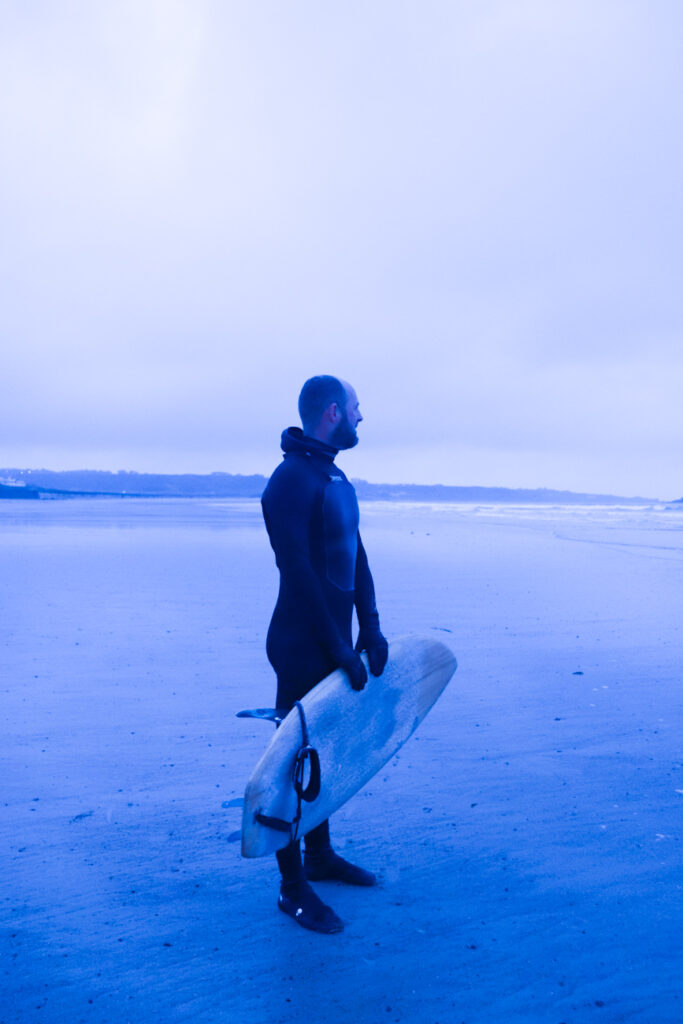
I also made some black and white, but made sure not to always do this because it can become boring if the images are all relatively repetitive. I then increased contrast and exposure.



I then began to explore a more natural lowering of the temperature, which created a nostalgic blue tinge that, when combined with a slight vignette and increased texture, appears film-like.





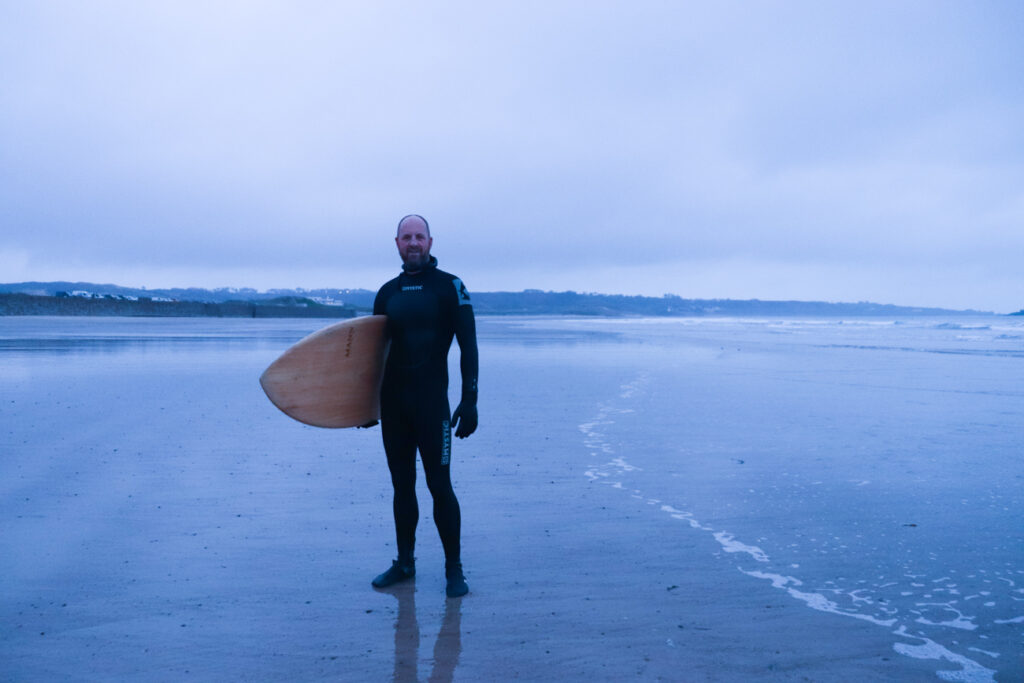
I edited the below portrait to be more natural and documentary style so that it would appear like an environmental portrait. I increased the exposure slightly as the original was very dark. I also increased contrast to show definition.

Here, I experimented with the opposite technique as before, where I increased temperature instead of decreasing it. I like the effect this has as it also seems quite nostalgic as it is reminiscent of sepia, but with a slightly more vivid tone.

Photoshoot 6, however, was a lot more successful as the light was better, the colours were brighter, and the visibility was clearer. This means that I have a lot more images from this shoot and I am generally very happy with these. Below are the photos I selected to edit.

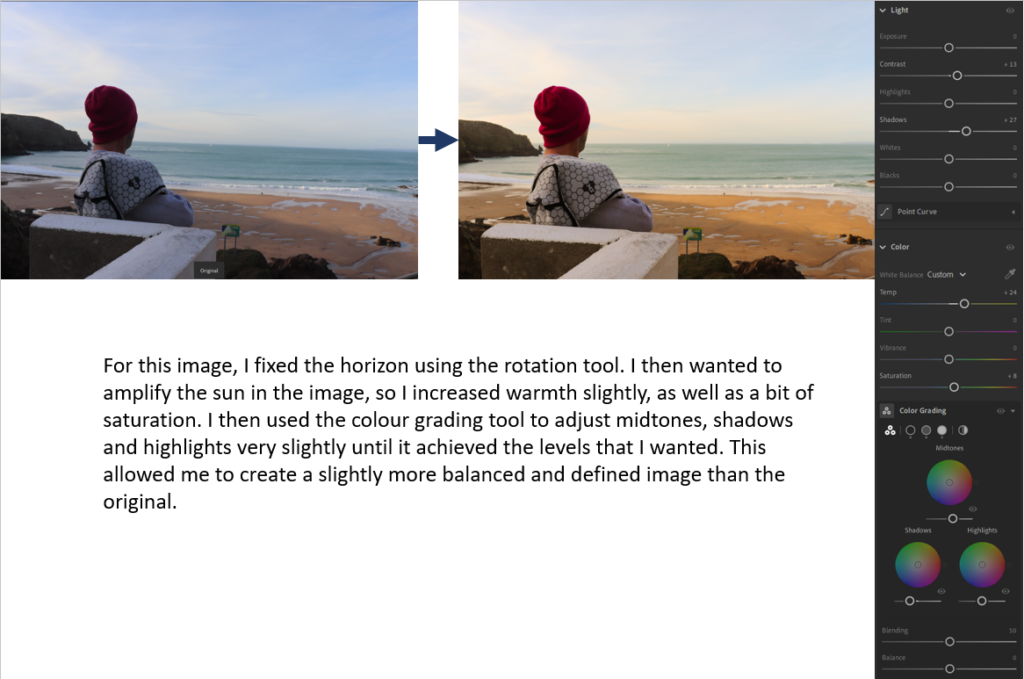


I copied and pasted these edits on to this photo too.



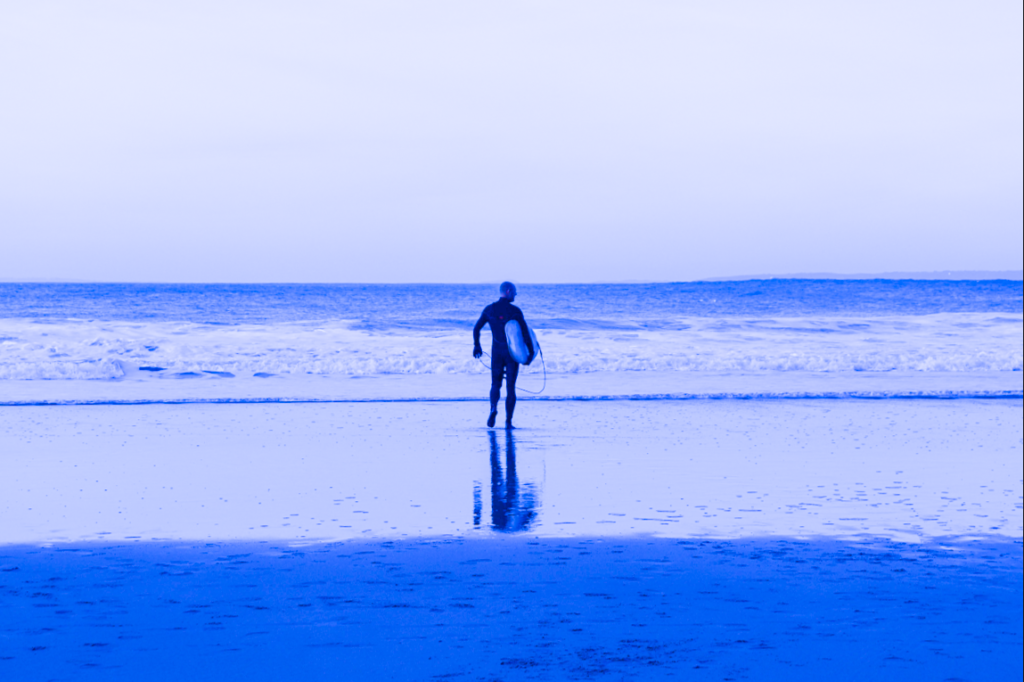





Mother by Matthew Finn was published in 2017. Finn created this series of images over thirty years, photographing his mother at random times, with no intention of creating an archive of images. He tells us in the introduction of the book why it was created. Him and his mother were very close because his father was very absent during his childhood.
‘My father never lived with us and many times he would make promises that he never kept. My mother would wait to be picked up for a night out with him. I can remember her standing there dressed in her fawn, mohair coat, and he wouldn’t turn up. Eventually, she would retreat upstairs to take off her make up and going-out clothes and then return to the TV. This seemed to happen a lot.’

Finn recounts that it was discovered, after his death, that Finn’s father had multiple families across Leeds. He discovered a plethora of half brothers and sisters who had been fathered by the same man. This brought him and his mother even closer.
‘The more I knew about my father, the more I felt a need to protect my mum, to wrap her up in cotton wool, to be the supportive man in her life, someone who would not let her down.’
He explains that his mother began to direct the photography, enjoying the feeling of being wanted or needed for something. His mother was diagnosed with mixed dementia in 2013 and this ended their collaboration – she no longer recognised herself or her son. This book acts as a testament to their life together and therefore holds a lot of sentimental value to the photographer.
Finn won the Jerwood/ Photoworks Awards in 2015 for this publication.
This Guardian interview with Finn explores a more detailed explanation of the work.

How does photography act as an important form of communication of both true and untrue subjects?
‘A photograph passes for incontrovertible proof that a given thing happened. The picture may distort; but there is always a presumption that something exists, or did exist, which is like what’s in the picture.’ (Sontag, 1977)
Ever since the dawn of photography, its usefulness, both in cultivating the mindset of the viewer toward the subject and in communicating a message visually, has been its allure. I will be analysing the work of pioneer photo essayist W. Eugene Smith, the widely commented-on war photographer Robert Capa, and important documentary photographer of the Depression era, Dorothea Lange. This is because their work all serves a function to tell a story. Whether or not it is a true story is the key to understanding the photographer’s individualism (and, arguably, integrity) as an artist.
Historically, the truthfulness of an image is always indefinite. Photography was first used by the rich to take family portraits. These were staged and composed entirely by the photographer. The subjects’ serious demeanours and plain body language is demonstrative in itself of just how far photography has evolved since those days of long exposures and big, inconvenient equipment. The equipment used to take pictures was yet another reason for the staging of photography; it was far easier to construct a composition than to allow the world to compose itself before a long exposure. There was an equivalent to ‘Photoshopping’ in the days before digital imagery – photographers would manipulate the darkroom development process to create images that were more appealing to their vision. Airbrushing, dodge and burn, and blurring were all tools used by the photographer to make small (and some less small) changes to their images. Therefore, the credibility of images throughout the history of photography is uncertain. Historian of Russia David King published a photobook in 1997 called The Commissar Vanishes, which discusses the erasure of enemies of the state in official photographs throughout the Stalinist era. It is described by King as ‘a terrifying – and often tragically funny – insight into one of the darkest chapters of modern history.’ (King, 1997)

It is a perfect demonstration of how the manipulation of photographs can alter how we view history and its events; and, hence, how important it is to maintain a discourse on the truthfulness of an image. The erasure of a subject means we have no way of telling exactly who was present at the time it was taken, which only contributes to the thick cloud of uncertainty around what exactly occurred during the terror era. Furthermore, a lack of transparency on what is staged and what is candid can also cause issues in determining history’s true events. The example I will discuss in this essay is Robert Capa’s Death of a Loyalist Soldier (1936), which is one of the most famously debated images of all time. In the case of more honest photographs – such as those taken in situ – they make accessible what is inaccessible; they allow those who, in a bygone age where travel is expensive and infrequent, cannot witness alternative lifestyles and cultures to their own to access this in a new medium. This is why the work of W. Eugene Smith was so important at the time; it was both educational and exciting for those who were unable to see it for themselves. Therefore, the importance of photography in relaying the events of history should not be understated – it is imperative that we as artists continue to use the medium to its advantages; to both document and inform.
The photo essays created by W. Eugene Smith between 1945 and his death in 1978 explore a variety of subjects, ranging from Minamata (1974), which explored the horrors of the mercury poisoning disaster in Minamata, Japan, to Nurse Midwife (1951), which told the story of an African American South Carolina nurse and midwife named Maude Callen. Smith’s work is constantly empathetic and he always worked tirelessly in his pursuit of the story – when photographing the invasion of Okinawa in 1945, he was critically wounded, and when he was photographing for his final essay in Japan, he was violently beaten by workers at the chemical factory who didn’t want his photographs to expose the suffering of the poison victims. This is illustrative of Smith’s devotion to his craft. This insatiable need to capture is a trait seen in many photographers, and it truly characterises his work. The structure of his photo essays has been replicated many times since they were published, by other artists who saw how successful the structure was in relaying the tale that Smith wanted to tell. This is perhaps why he has repeatedly been described as ‘perhaps one of the greatest photojournalists America has ever produced.’ (McGuire, 1999), and it is said that ‘the combination of innovation, integrity, and technical mastery in his photography made his work the standard by which photojournalism was measured for many years.’ (The International Center of Photography (ICP), n.d.) By using his photography as a way of communicating stories, Smith, and countless others like him, is an important example of how photography is, first and foremost, a medium through which to craft a narrative.

Robert Capa is widely renowned for his work photographing the Spanish Civil War in 1936, and chiefly for his most famous image, Death of a Loyalist Soldier (1936). This image was supposedly taken above a trench after Capa ‘just kind of put [his] camera above [his] head and even [sic] didn’t look and clicked the picture, when they moved over the trench’ (Capa, 1947) but came under suspicion in the 1970s, when other staged images were discovered to have been taken in the same place at the same time. In 2009, José Manuel Susperregui of the University of País Vasco published Sombras de la Fotografía (“Shadows of Photography”), which asserted, by analysing the mountain ranges in the background of the sequence, that the image was taken in Espejo, some 50 kilometres from the alleged location at Cerro Muriano. Whether or not this reflects positively or negatively on Capa as a photographer is up to the viewer; is it wrong to deceive the world if the pictures still serve the intended purpose, or is it dishonest to incorrectly document history?

Another artist whose work could be construed as dishonest is Dorothea Lange, most famous for her documentary photography during the Depression era in America. Travelling through California whilst working for a government agency responsible for providing aid to struggling farmers, Lange took her most famed image, Migrant Mother, in 1936. This image is renowned for its captivating, evocative tone, and it is still viewed worldwide as an important insight into civilian life in Depression era America. However, I am more concerned with two images taken by Lange three years later, in 1939. The first, shown below, was taken after the photographer introduced herself and asked to take their picture. The subjects smile and the father wipes the baby’s face.

The photo that became more famous, after it was used by the Farm Security Administration (FSA) to demonstrate the effects of the Depression, was this one.

It is clearly the un-staged version; where the photographer has captured the subjects’ natural states. The general caption for this series of images reads ‘The car is parked outside the Employment Office. The family have arrived, before opening of the potato season. They have been on the road for one month–have sick baby…Father washed the baby’s face with edge of blanket dampened from canteen, for the photographs’ (Mason, 2010). This shows that Lange does not intentionally represent the effects of the Depression in this way; it is instead the FSA that widely publicise this particular version of the photograph. This is because the organisation has an agenda to bring awareness to the issues caused by the government mismanagement and hyperinflation of the time, especially in rural California, where the issue of the Dustbowl caused an extreme lack of fertile ground and, hence, a widespread hunger. This therefore has a very palpable effect on how we view the period; we are not able to imagine what life could have been like unless we personally experienced it, and, therefore, photographs are the tool we use to unlock the intricate details (fairly modern) history. This therefore demonstrates once again how important it is to understand and also challenge the source of an image – who took it and why? What could their intentions have been? Were they commissioned to take it? If we neglect to, we could fall into the trap of passing history down incorrectly.
Overall, it is clear that the importance of photography lies very firmly in its power as a window into the past, and into the presently inaccessible. One reason that humans are inherently captivated by the medium is the way in which it allows us to freeze time forever in a single exposure that appears exactly how it appeared to us in the moment. There are of course, as I have explored in this essay, many ways in which a photographer can manipulate the scene, so it is different to how it appeared in the moment, and this is a further reason as to why we feel such attraction to photography; it allows us to become puppeteers, narrators, and storytellers. I think that this holds importance as it reveals that the human race are programmed to tell stories, whether these be true or untrue, and that they enjoy the consumption of such stories. The existence of photographic archives all over the globe demonstrates further that history is only as rich as we make it; we are the creators of ‘history’, and so we are responsible for the maintenance of its truths.
Capa, R., 1947. Bob Capa Tells of Photographic Experiences Abroad [Interview] (20 October 1947).
King, D., 1997. The Commissar Vanishes. 1st ed. London: Tate Publishing.
Mason, J. E., 2010. How Photography Lies, Even When It’s Telling the Truth: FSA Photography & the Great Depression. [Online]
Available at: https://johnedwinmason.typepad.com/john_edwin_mason_photogra/2010/03/how_photography_lies.html
[Accessed 22 January 2024].
McGuire, R., 1999. Unforgettable book combines art, artifact ‘W. Eugene Smith, Photographs, 1934-1975’. [Online]
Available at: http://edition.cnn.com/books/reviews/9901/04/eugene.smith/
[Accessed 19 January 2024].
Sontag, S., 1977. On Photography. 1st ed. New York: Farrar, Straus and Giroux.
The International Center of Photography (ICP), n.d. Artist: W. Eugene Smith. [Online]
Available at: https://www.icp.org/browse/archive/constituents/w-eugene-smith?all/all/all/all/0
[Accessed 19 January 2024].